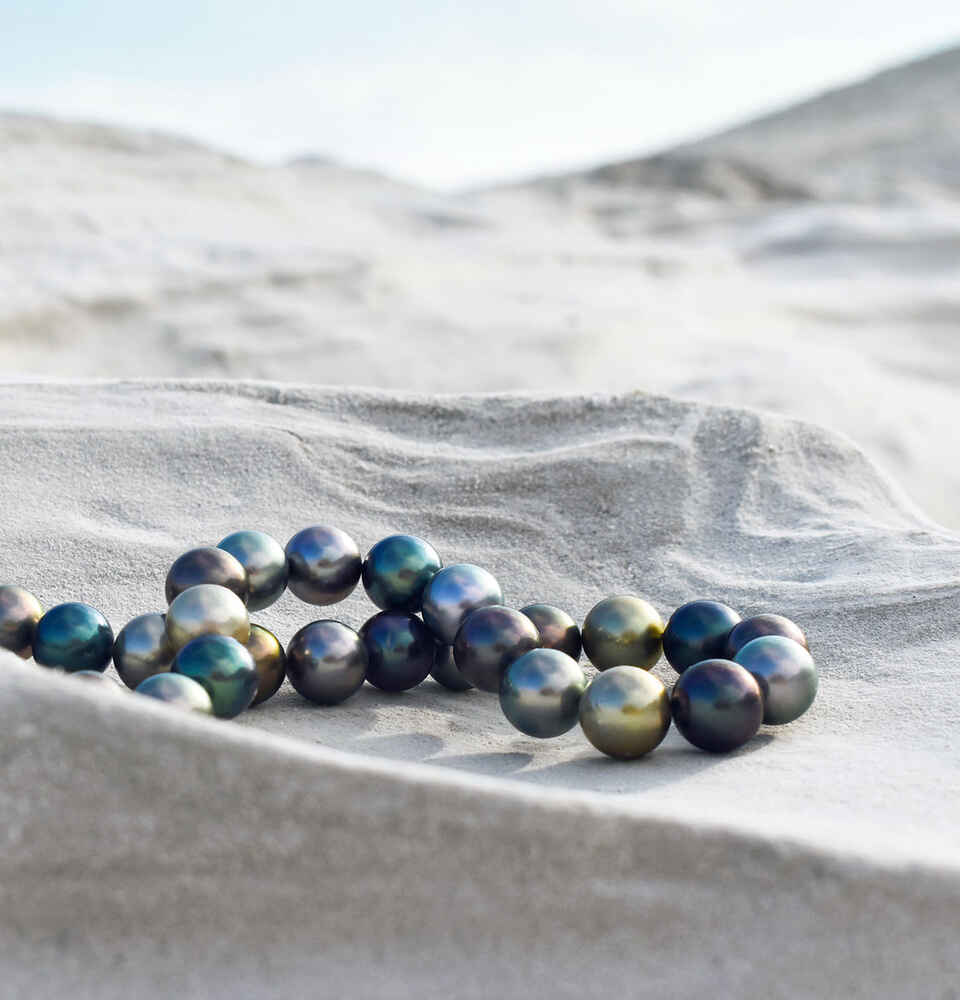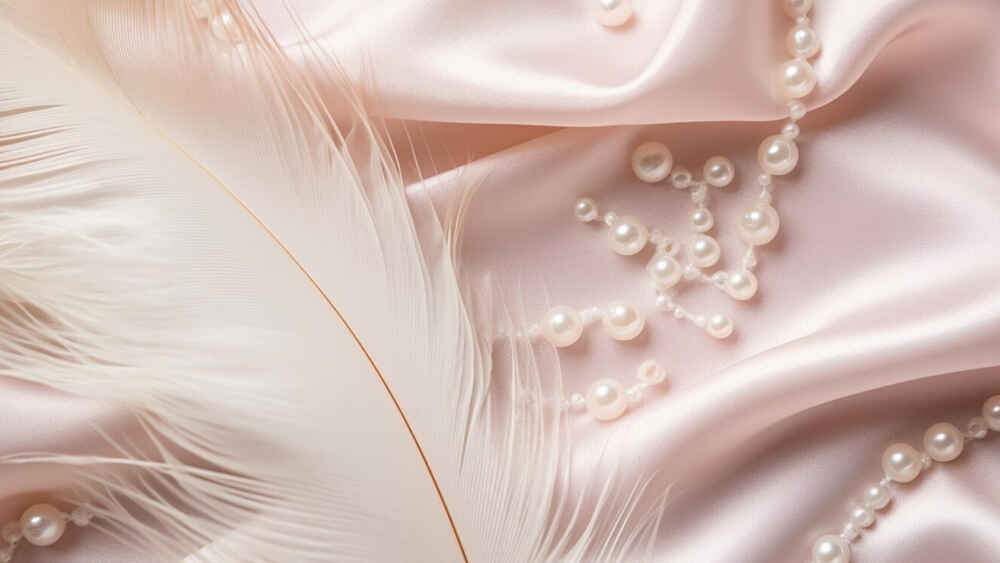Bead types at a glance
Akoya pearls have been produced in Japan since 1916. The appearance of the small, white pearl has always characterized the image of a perfect pearl. Today, Akoya pearls predominantly shine in the colors white-pink, cream and silver-grey and are largely sourced from Chinese cultivation and waters. Japanese and Chinese companies often work closely together on this.
The Akoya oyster is the smallest oyster produced by a pearl species. The pearls therefore only reach an average size of two to nine millimetres. The classic Akoya pearl oyster is the "Pinctada nartensii", which grows to just ten centimetres in size. The mother-of-pearl layers are also often much thinner than those of other saltwater pearls. The breeding of an Akoya pearl begins in the summer with implantation. As with other saltwater cultured pearls, several mother-of-pearl beads and the mantle tissue of a donor mussel are implanted into the mussel.
The bead acts as a shaper for the pearl and the cells of the mantle tissue have the ability to produce nacre. Without the tissue, the saltwater mussel would not produce mother-of-pearl. The mantle tissue is the skin that surrounds the inner mussel body and forms the shell on the outside. After a growth period of at least 10 to 14 months, the pearl species is harvested in winter, as this is when the lustre of the Akoya pearls is at its strongest.
Driven by the success of Akoya cultured pearls from Japan, cultivators from Burma, Australia, Indonesia and the Philippines also began cultivating a type of pearl in large tropical shells at the beginning of the 20th century. The Japanese gave the South Sea pearls their name, as this type of pearl is still cultivated in the seas south of Japan today. In Australia, pearl farming was initially seen as a threat to natural pearls and was criminalized from 1922 to 1949.
The South Sea pearl species is cultivated in the "Pinctada maxima" mussel, which is further subdivided into a golden-lipped and a silver-lipped species. In the wild, these mussels can grow up to 30 cm in size and weigh up to five kilograms. Most of the mussels used for pearl farming today are home-grown, as in natural conditions the mussels burrow several meters into the sand on the seabed and are therefore difficult to find.
An average South Sea pearl is ten to twelve millimetres in size and has a harvest period of around two years. On average, it is the largest of the pearl species and is therefore traded at the highest prices. If a South Sea mussel leaves a vital impression after the first harvest, it can be used again to grow pearls. The implanted spheres can now be around the size of the harvested pearls, ten to twelve millimeters, and the South Sea pearls from the second harvest are correspondingly larger, around 15mm. In individual cases, mussels of this pearl species are even implanted a third time and then produce pearls up to 20mm in size, but these are very rare.
Thanks to its size, the South Sea cultured pearl is considered the queen of cultured pearls. With a color spectrum ranging from silver-white and white-pink to fine cream and champagne tones, it is also ideal for jewelry. Today, Indonesia, Australia and the Philippines are among the largest producers of South Sea pearls.
"They're just dark-colored Akoya pearls!" - was the initial belief. When this fallacy was debunked in the 1980s, prices for Tahitian pearls skyrocketed and even surpassed those of the large South Sea pearls at times. At that time, it was scientifically proven that the color of the pearl species sometimes referred to as "black pearls" is absolutely natural and that they are not dyed Akoya pearls.
Tahitian pearls are very rarely actually black. Instead, their color spectrum ranges from silver-grey to blue-green, eggplant and bronze. However, being called a "black pearl" has given Tahitian pearls a lot of public attention and helped them to surpass the prices of the larger South Sea pearls. Now that the hype surrounding the supposedly black pearl has cooled down, the prices have also been put into perspective.
This pearl species is characterized by its metallic sheen and changing shades. The dark pearls are cultivated in the "Pinctada margaritifera", a mussel that can grow up to 30 cm in size and live for 30 years in the wild. Here too, healthy mussels can be used a second time for pearl cultivation and then produce larger specimens, although pearls over 16mm are very rare. Although the name may suggest it, the origin of this pearl species is not Tahiti itself, but the island and coral-rich surrounding area. The main place of production is French Polynesia.
In contrast to Akoya, South Sea and Tahitian pearls, freshwater pearls are not cultivated in the sea, but in lakes and rivers. The cultivation method also differs from that of saltwater pearls. As a rule, only a piece of tissue from a donor mussel is implanted rather than a bead, as this is sufficient to stimulate the production of a pearl in freshwater mussels. However, there is still no scientific explanation for this phenomenon. Without this shaping element, however, the pearls are often not as round as the related pearl species from the oceans.
In the meantime, however, the production of freshwater pearls has developed so much that the difference is hardly noticeable in good specimens. Since there is no need to insert a bead or nucleus, implanting the three to four millimeter piece of tissue does not put as much strain on the shell as implanting a mother-of-pearl bead into a saltwater pearl. Baroque, non-round shapes can also be interesting for certain pieces of jewelry. The color spectrum ranges from white-pink to salmon orange to brown-violet. The pearls are up to 13mm in size.
The undisputed main producer of freshwater pearls is the People's Republic of China. In the 1980s, pearl farming became interesting for many Chinese farmers, as the markets were opened up when Deng Xiao Ping came to power in 1978. However, the farmers only had rudimentary knowledge and initially produced poor quality pearls.
In the 1990s, pearl cultivation in China was largely professionalized. Occasionally, freshwater pearls are also cultivated using a mother-of-pearl core, as this is expected to produce even rounder and larger shapes, such as the Japanese Kasumigaura cultured pearl.








